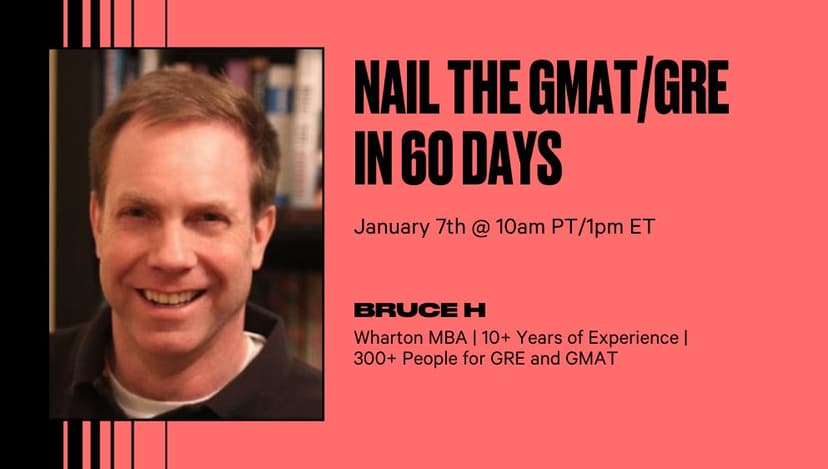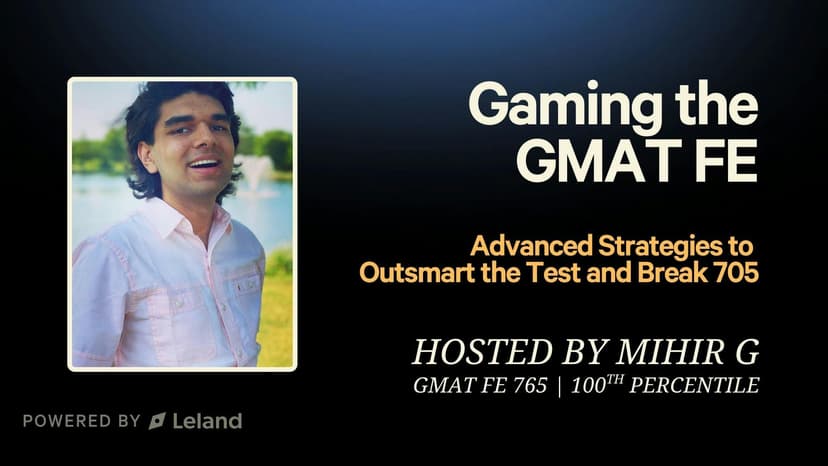GMAT Data Sufficiency: Strategy Guide, Question Types, and Pitfalls to Avoid
Master GMAT data sufficiency with expert-backed strategies, real examples, and a proven step-by-step framework to boost your quant score.

By Mihir G.
Custom GMAT Strategy | 765 Score (100th Percentile) | Chicago Booth Admit
Posted June 13, 2025

Join a free event
Learn from top coaches and industry experts in live, interactive sessions you can join for free.
Table of Contents
solve this or just analyze it?" You’re not alone. These problems are designed to trip you up, not because they’re the hardest math, but because they flip the rules. You’re not solving for a value. You’re deciding whether you can even solve for one.
As a GMAT coach, I’ve helped dozens of students build the logic and discipline it takes to master Data Sufficiency questions in the new Data Insights Section. It’s not about doing more math – it’s about thinking differently under pressure.
This guide will help you master that mindset shift. I’ll break down the question format, show you how top scorers approach them, and share real strategies for avoiding the traps that tank most test-takers. Whether you’re aiming for a 705+ or just trying to feel less shaky on DS questions, this is your roadmap.
Read: 3 Things You Need to Know About the New GMAT Focus Edition
What Makes GMAT Data Sufficiency Questions Test Different?
Data sufficiency makes up about 40% of the GMAT Focus Edition New Data Insights Section, so mastering it is essential. But they don’t just test your math skills. They test critical thinking, logic, and your ability to analyze what’s relevant and what’s not. That’s why many top scorers say they felt like they were training their brain, not just reviewing formulas.
Each question includes a question stem (what you're trying to figure out) and two statements, labeled (1) and (2). Your job isn’t to find the final answer. Instead, you must decide whether the statements provide enough information to answer the question, either alone or together.
You’ll always see the same five answer choices, which reflect different combinations of sufficiency:
- Statement (1) alone is sufficient, (2) alone is not
- Statement (2) alone is sufficient, (1) alone is not
- Both together are sufficient, but neither alone is
- Each statement alone is sufficient
- Neither statement is sufficient, even together
Some questions are straightforward (e.g., solve for a value), while others are yes/no questions, or can even ask you to synthesize qualitative information. In those cases, your job is to determine whether the information consistently leads to a clear “yes” or “no.”
Read: How Long is the GMAT (Focus Edition)? Breakdown by Section & Total
The Five Answer Choices (Know Them Cold)
Memorizing the answer choices will save precious time:
- Statement (1) alone is sufficient, but Statement (2) is not
- Statement (2) alone is sufficient, but Statement (1) is not
- Both statements together are sufficient, but neither alone is
- Each statement alone is sufficient
- Statements (1) and (2) together are not sufficient
Knowing these lets you focus on logic, not decoding options. Think of them as a decision tree, not a guessing game.
Common Mistakes That Sink Your Score
I have found that top scorers on the GMAT often say the hardest part of data sufficiency questions isn’t the math, but the mindset. Here are frequent traps:
- Solving when you don’t have to. Your goal is to find a sufficient answer, not the actual value.
- Not testing edge cases. For example, in a positive integer question, don’t forget to test zero, negatives, or fractions if allowed.
- Assuming a “yes” or “no” is enough. You need a definitive answer to the question asked, not just a possibility.
- Overlooking “alone is not sufficient.” Many fall into this when one statement seems close, but doesn’t fully answer the question.
- Rushing through logic. Always test both statements thoroughly. Misjudging one can cost you the correct answer.
Read: The 10 Most Common Mistakes in GMAT Exam Prep and How to Avoid Them
Real-World Strategies from High-Scoring GMAT Takers
These aren’t generic tips; they come from 705+ scorers who’ve mastered data sufficiency questions under time pressure. What separates them from average test-takers isn’t just content knowledge; it’s how they think during the test. Here’s how to train your brain the same way:
Use a Decision Framework for Every Statement
High scorers don’t casually label statements—they run them through a mental sufficiency test:
- Always sufficient – leads to a single, definitive answer
- Always insufficient -- results in multiple or conflicting answers
- Depends on values -- often yields both a yes and a no answer → insufficient
By forcing yourself to categorize each statement with this lens, you reduce the chance of misjudging borderline cases.
Plug in Edge Cases, Not Just Easy Numbers
It’s tempting to test 1, 2, or 10, but that’s not enough. Experts deliberately test:
- Zero
- Negatives
- Fractions
- Large values
This is especially important in value questions or number property problems, where plug-ins reveal whether a statement alone is not sufficient. Always test extremes to catch hidden traps.
Eliminate Strategically Using Answer Choice Logic
Top scorers don’t second-guess all five options. They use sufficient outcomes to eliminate by group:
- If (1) is sufficient, eliminate B, C, and E
- If (1) is insufficient, eliminate A and D
This narrows the field fast, especially useful when a second statement feels ambiguous.
I have found it easiest to first focus on analyzing if (1) is sufficient alone, then if (2) is sufficient alone, then if they are sufficient together. Doing this can streamline your logic and thought process and save time. You are only checking three options instead of 5 (more on this later)!
Treat Each Statement Independently – No Carryover Thinking
One of the most common and costly errors? Letting info from statement 1 influence how you evaluate statement 2. Experts isolate each one completely. They reset mentally and pretend they’ve never seen the first.
Just because two statements look similar doesn’t mean they’re considered sufficient for the same reasons. Many students over-assume symmetry and miss the correct answer.
A Step-by-Step Framework That Works
Step 1: Read the Question Stem With Precision
Start by identifying what kind of question you’re being asked. Is it a value question, where you're solving for a specific number? A yes/no question, where are you determining if something is true? Or an inequality question, which asks how two values compare (like “Is x > y?”)?
Carefully scan for any given constraints, like whether a variable must be a positive integer. These restrictions directly impact how you interpret each statement. Misreading the question stem is one of the fastest ways to eliminate a correct answer. Read it twice if there’s any ambiguity.
Step 2: Evaluate Statement (1) Alone
Ignore statement (2) entirely and focus only on statement (1). Ask yourself: Is this statement alone sufficient to definitively answer the question in all possible scenarios?
Plug in multiple values, especially edge cases like zero, negatives, or fractions. If every test leads to the same result, the statement is sufficient. But if different plug-ins give both a yes and a no answer, the statement is not sufficient.
Step 3: Evaluate Statement (2) Alone
Now, mentally reset and evaluate statement (2) on its own. No assumptions from statement (1) should carry over. Use the same testing logic: plug in values, check consistency, and look for ambiguity.
Be especially cautious if the second statement looks similar to the first. Just because two statements appear alike doesn’t mean they’re equally sufficient. Treat each one independently and evaluate based on results, not assumptions.
Step 4: Evaluate the Statements Together
Only combine the statements if both were insufficient alone. Now ask: do they, when used together, provide sufficient information to arrive at one definitive, unambiguous answer?
If you still can't determine the outcome, or if different value sets still allow multiple answers, then the correct answer is E: the two statements together are not sufficient.
Watch out for trap setups where combining the statements gives the illusion of completeness. Always test with real numbers when you're unsure.
Step 5: Select the Best Answer Choice (with Logic)
Use your outcomes to eliminate quickly:
| Outcome | Correct Answer |
|---|---|
| Only (1) is sufficient | A |
| Only (2) is sufficient | B |
| Both together, neither alone | C |
| Each alone is sufficient | D |
| Even together, not sufficient | E |
Types of GMAT Data Sufficiency Questions You’ll See
Understanding the categories can help you spot the right strategy faster:
- Value questions: Ask for a specific number or value
- Yes/no questions: Ask whether something is true
- Inequality questions: Require careful logic with ranges
- Geometry or number properties: Often hides traps in constraints
- Word problems: May involve translating complex, qualitative phrasing
The hardest ones often combine concepts, like a positive integer in a geometry value question.
How to Practice (the Smart Way)
Practicing data sufficiency isn’t just about doing problems. It's about refining how you think.
- Use official problems whenever possible; they reflect the real math test logic.
- Time yourself. Pacing is key in the GMAT quant section.
- Keep an error log. Write down what made a statement seem considered sufficient when it wasn’t.
- Try a “1-minute test” for each problem: can you determine if the statement alone is sufficient in under a minute?
Read: How to Study for GMAT: The GMAT Tutor's Guide
Struggling to improve despite practice? Work with me to pinpoint exactly where your logic is breaking down – and how to fix it.
Sample GMAT Question Walkthrough (With Strategy)
Question: Is x > 0?
(1) x² = 4(2) x is a positive integer
Let’s walk through it:
- Statement 1 alone: x = 2 or -2. Not sufficient (could be negative).
- Statement 2 alone: x is positive. That’s enough. Sufficient.
- Correct answer: B
What this tests: recognizing when a single statement gives a definitive answer and when it leaves ambiguity.
Building Your Study Plan for Data Sufficiency
Improving takes time, but it’s absolutely doable. Here’s a weekly structure:
| Day | Focus | Why It Matters |
|---|---|---|
| Mon | 10–15 mixed difficulty DS questions + deep review | Start your week with broad exposure. Time yourself, then review every miss. Identify whether the issue was math, logic, or misreading the question stem. Build your error log to track patterns. |
| Tue | Drill value questions | These are the most common type, and often the trickiest. Practice identifying when a statement alone is not sufficient, especially when plug-ins produce both a yes and a no answer. Test edge cases. |
| Wed | Focus on word problems and geometry DS | These question types tend to be more abstract. Translate wordy stems into equations, and review geometry rules (angles, area, ratios). Watch out for traps in positive integer constraints. |
| Thu | Timed mini-set: 10 DS questions (under 20 mins) | Build test-day pacing. Apply the step-by-step sufficiency framework. Track how long you spend on each statement and whether you're second-guessing. |
| Fri | Analyze your toughest problems of the week | Re-do questions you got wrong without checking the explanation. Can you now reach a definitive answer using clean logic? Log all lingering gaps and review relevant quant concepts. |
| Sat | Full quant section or 20+ DS questions (timed) | Simulate test conditions. Include a mix of value, yes/no, and inequality questions. Use official GMAT material where possible. |
| Sun | Rest, reflect, or review weak areas | Light review day. Watch a video breakdown of tough DS problems, revisit pure math fundamentals (e.g., algebra, inequalities), or meet with a coach to refine strategy. |
Include time for concept review—pure math, algebra, inequalities—so you can solve quickly without stumbling on fundamentals.
My Tips to Improve Fast
- Know when a statement alone is not sufficient – don’t try to force it.
- Don’t skip re-reading the question stem if you’re unsure.
- Use every question to sharpen how you think, not just what you know.
- Repetition builds speed. Pattern recognition builds accuracy.
- Always review all answer choices – even when you’re confident. One careless miss can undo great logic.
Crushing GMAT data sufficiency isn’t about memorizing tricks. It’s about learning to think like the test: with clarity, logic, and discipline under pressure. Once you stop trying to “solve” every question and start evaluating information strategically, the section gets a lot more manageable – and your score will show it.
But that shift doesn’t happen overnight. And if you’re in that frustrating “I sort of get it, but I still miss too many” phase, you’re not alone. I’ve worked with a lot of students in that exact spot, and the good news is, it’s fixable. With the right strategy and feedback, you can move past it fast.
If you want help identifying your blind spots, tightening your logic, and building a plan that fits your timeline, I’d love to work with you.
Read these next:
- GMAT Verbal Section: How to Get the Highest Possible Score
- GMAT Focus Score Chart With Percentiles
- GMAT Study Plan: Strategies to Ace Your Prep and Achieve Success
- How Hard is the GMAT (Actually)?
GMAT Data Sufficiency – FAQs
How does the computer-adaptive format affect Data Sufficiency questions?
- The GMAT is computer-adaptive, meaning the difficulty of questions adjusts based on your performance. Answering Data Sufficiency questions correctly can lead to more challenging questions, improving your overall score.
Can I use a calculator during the Data Insights section?
- Yes, an on-screen calculator will be provided on the Data Insights section, which contains the Data Sufficiency Questions. Importantly, you will not be allowed to use a calculator on the Quantitative Section or Verbal Sections of the GMAT Focus Edition.
What types of math concepts are tested in Data Sufficiency questions?
- Data Sufficiency questions assess your understanding of arithmetic, algebra, and geometry. They test your ability to reason quantitatively and determine the sufficiency of given data. You may also find qualitative questions that don’t require mathematical calculations.
How should I approach answering Data Sufficiency questions?
- A strategic approach involves evaluating each statement independently to determine if it provides sufficient information to answer the question. If neither statement is sufficient alone, assess whether the two statements combined provide enough information.

Written by Mihir
5.0
(20)
Mihir has helped clients get into organizations like:
Browse hundreds of expert coaches
Leland coaches have helped thousands of people achieve their goals. A dedicated mentor can make all the difference.


















